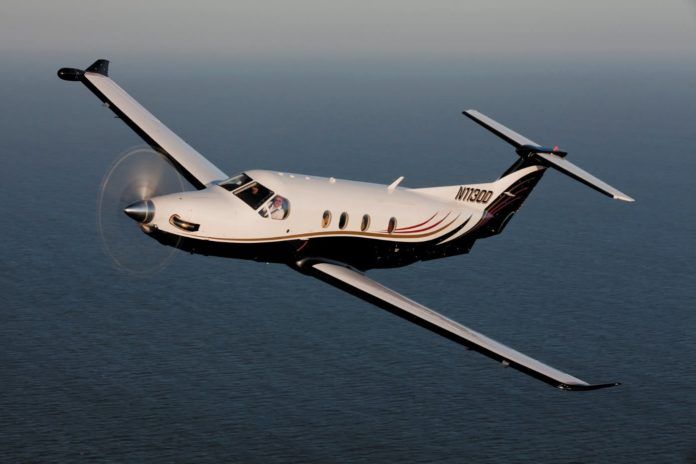Some airplane manufacturers build a model based on what it thinks a typical private owner might do with it. Not Swiss manufacturer Pilatus. For decades Pilatus has built models—including the PC-12 turboprop single—to specifically meet the missions of armed services throughout the world, including the U.S. Air Force (U-28A). Moreover, the PC-12’s launch customer was the Royal Flying Doctor Service of Australia for its work in the extremes of the outback—an environment that suits the PC-12 just fine. Got unimproved runways? The PC-12’s oversized tires can handle it, while trailing-link landing gear and an effective rudder make the single-pilot-approved big turboprop easy to land.
Still, the PC-12 turned out to be more versatile than perhaps even Pilatus envisioned. That’s because it works just as we’ll hauling owner-flown dirt bikes (we’re talking motorcycles, by the way) as it does corporate executives and charter passengers, thanks to a posh rear cabin that’s configurable in several seating arrangements. Pilatus is hardly a newcomer to the aircraft market.
Formed in 1939, Pilatus Aircraft Limited rolled out its first aircraft in 1945 and enjoyed much success with training and utility aircraft, including the P-2, P-3, PC-7, PC-9 and the PC-21. Before the PC-12, however, Pilatus was we’ll known for the PC-6 Porter, a STOL-equipped utilitarian turboprop single that is popular for hauling skydivers, among filling other unique missions. But the Pratt PT6A-powered PC-12 is different, combining impressive amounts of utility with high-end styling and performance, including a nearly cross-continental range and a cruise speed that flirts with 280 knots in newer models.
Strap in to a PC-12’s BWM-designed interior and you’ll appreciate a generous fit and finish that you should expect from an airplane with a price tag that’s we’ll north of $1.5 million for an older model and $3.5 million-plus for a newer one.
Model Series
Pilatus delivered the first PC-12s in 1994, starting with the model PC-12/41, which had a 9039-pound maximum takeoff weight. If you’re searching the used market for an early one, you’ll be hard pressed to find a PC-12/41 that hasn’t be modded (via landing gear mod and a paperwork change) for a 9920-pound maximum takeoff weight, essentially making it a PC-12/45 designation—the second series of PC-12 introduced around 1996. Up until the current PC-12NG model, Pilatus incrementally bundled modifications and improvements into 11 groups of airframe serial numbers. This means if you were to buy a new PC-12, it would incorporate all of the improvements made to the aircraft over time. But if you’re shopping the used market, you’ll focus on the more significant changes associated with a given series. Some upgrades (through service bulletins) were more substantial than others.
For example, the series three (serial numbers 141-160) brought the previously mentioned gross weight increase from 9040 pounds to 9920 pounds (which ultimately became standard beginning with serial number 181). Series four (serial numbers 161-180) brought new pilot and copilot seating with improved adjustment mechanisms, plus passenger seats certified for the increased gross weight. Series five (serial numbers 181-200) included new heat ducting in the cabin, a new oxygen shutoff lever in the cockpit, a 60-second engine start relay, plus head impact modifications to the passenger seating. More major modifications were incorporated in series 10 aircraft, starting with serial number 401 through 888 (later serial numbers upgraded the aircraft to the PC-12/47). This included a new EIS, which incorporated an engine condition monitoring system (ECMS), allowing the EIS to capture all critical engine parameters for download to a laptop computer for engine trend analysis. There were also some avionics upgrades, including the addition of the Bendix/King KLN90B approach-approved GPS, the KMD850 multifunction display, EGPWS, weather radar and TCAS.
It’s worth noting that many early PC-12s have substantial aftermarket avionics upgrades, which might replace the Bendix/King avionics with Garmin GNS530 and GNS430 navigators, plus Garmin G600 PFD to replace Bendix/King EFIS displays. Earlier models had Universal EFIS.
Outside the aircraft, the dash 47 model brought new winglets, a new empennage dorsal fin, new ailerons for better roll handling and new LED lighting. The series 11 is the current dash 47E model PC-12NG, which begins with serial number 1001. More on this model in a minute.
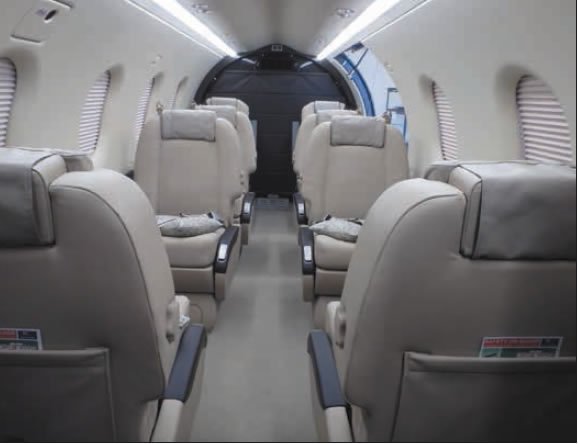
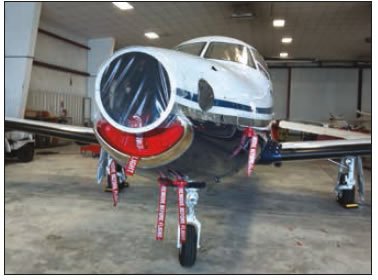
Major Systems, Loading
The PC-12’s flight controls are cable driven, although the ailerons have pushrods in some sections. Unlike the Cessna Caravan and even Socata’s TBM-series turboprop, the PC-12 doesn’t have spoilers for roll control, thanks to the smaller aileron size.
After some complaints about heavy ailerons, Pilatus installed servo tabs on the ailerons, which, combined with the third generation of winglet design, delivered acceptable roll forces and response, nicely harmonized with pitch and rudder forces and an aileron/rudder interconnect. Max flap travel of the semi-Fowler flaps is 40 degrees. In flight, that allows for a dramatically steep rate of descent at 85 KIAS.
There are angle-of-attack vanes on each wing, providing data to dual AOA systems that drive a stick shaker and pusher. Stalls are prohibited, as the airplane could not meet the certification requirements regarding maximum roll-off at the stall break with full flaps and full power. AoA data is displayed on the flight director (and on the PFD in the NG model), which makes holding the right speed for a given landing weight easy. At max takeoff weight, stall speed is 67 knots.

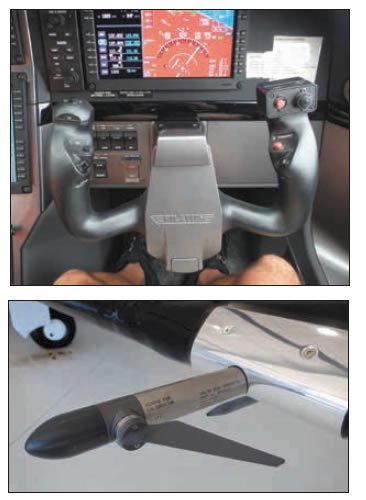
Up front, a 1605-SHP Pratt and Whitney PT6A-67B spins a four-blade, full-feathering Hartzell prop. On pre-NG models, the engine is derated to 1200 SHP for five minutes on takeoff and 1000 SHP for continuous operation.
Max gross weight for the PC-12 is 10,495 pounds, with max takeoff at 10,450 pounds. The early-gen PC-12 Aviation Consumer flew back in 2007 for a review weighed 6474 pounds empty, giving it a useful load of 4021 pounds. With all 2704 pounds of fuel aboard, 1317 pounds may be carried in the cabin, or six 200 pounders and more than 100 pounds of baggage. For the pilot-plus-four range question used for evaluating VLJs and single-engine turboprops at the time, the answer for the older PC-12 is that a pilot plus five can still carry full fuel and go 1500 nautical miles at max speed cruise with NBAA reserves, meaning it can miss the approach and go to an alternate 100 miles away.
The zero-fuel weight is 9040 pounds, which allows a hefty 2566 pounds in the cabin. In sample loading problems, we found that with just two people up front, the airplane was near the forward CG limit. Keeping just the pilot aboard and then loading the maximum 400 pounds in the aft baggage area (behind the rear seats) and then 500 pounds in the back end of the cabin, moved the CG to near the aft limit, indicating a satisfactory CG range in service. Max landing weight is 9920 pounds, so 575 pounds of fuel have to be burned off following a max gross launch.
For occupant protection in an accident, no hydraulic or fuel lines penetrate the pressure vessel and the 406 gallons of fuel (402 gallons usable) in the wings (53-foot 4-inch span) is as far outboard as possible. Fuel balancing is automated, so the pilot doesn’t have to mess with tank selection or take any action unless the system should fail or a line person fills one tank much more than the other.
The upside is that it was done in a fashion that fuel burn doesn’t affect the aircraft’s center of gravity; the downside is that there’s fuel all the way to the leading edge, so it’s only protected by a deicer boot and the leading edge aluminum in the event of a crash. Pilatus pointed out that the wing skin is made of stiffened clad aluminum alloy, riveted to the spar and ribs. The PC-12 does not have easily punctured fuel tanks and, to our knowledge, has never experienced a fuel leak as a result of minor wing damage or a fire due to major wing damage.
Virtually all of the systems, as we’ll as the engine, can be accessed via doors or hatches that unlatch and swing open easily—only one access port has to be unscrewed during a 100-hour inspection. Lubrication oil quantity is checked via a sight gauge after landing, reducing the chance of engine failure because someone forgot to replace the dipstick correctly. The oil filler cap has a vertical stripe of paint on it to quickly indicate if it’s correctly screwed on.
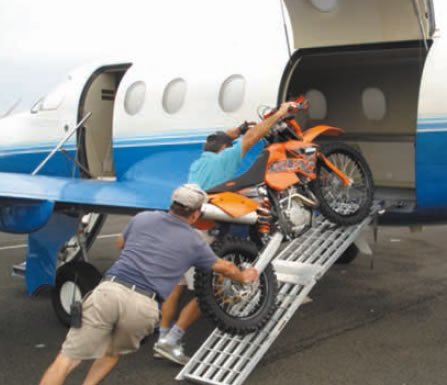
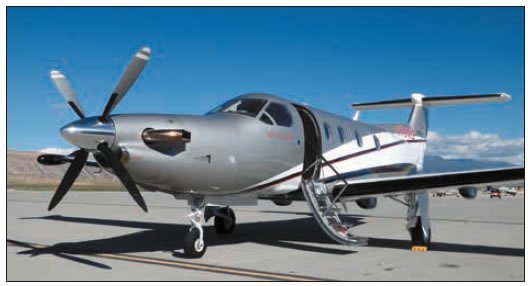
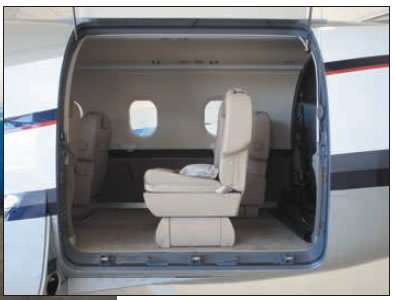
Cabin, Cockpit Controls
Until the advent of the PC-12, it was often said the workhorse of general aviation missions was the Beech B200 King Air. It’s no surprise that the PC-12 was designed to be generally similar in size and performance to the King Air, but at a sizable cost advantage with only one engine.
At 5 feet wide with nearly 5 feet of headroom, the PC-12’s cabin is slightly larger than a King Air 200, with the extra width noticeable once inside. The seats recline and swivel and have three-point restraints. There’s also a potty opposite the airstair door, with its own solid door for privacy.
Speaking of doors, the head-turner with a PC-12 is its 53- by 52-inch aft cargo door. It’s hinged to open vertically hydraulically, although it closes via an electric motor and can also be operated manually. The latching mechanism for it and the main cabin door is easy to operate and the telltales showing the position of the latching pins were obvious and easy to read. A forklift can approach the fuselage at a 90-degree angle. The cockpit is comfortable for virtually any size pilot. The step past the console is not particularly difficult and while we would prefer a side stick from a crashworthiness perspective, the control yoke slides out of the panel so there’s no column to take up floor space. The crew seats adjust vertically and horizontally, tilt, have lumbar support and four-point restraints. One unusual feature in an airplane this size is adjustable rudder pedals, which allows the pilot to obtain the eye position recommended by lining up two small balls on top of the magnetic compass.
The PC-12 has an all-electric trim system, controlled via a toggle on each control yoke. Power control is single-lever, just like a jet, with no manual RPM control.
Starting a PC-12 is conventional for a turboprop. Hit the starter button, then introduce fuel at about 14 percent RPM and monitor to assure the start stays within temperature parameters. Once the PT-6 is running, the two generators and avionics master switches are turned on and it’s time to taxi.
Once off the runway (with a 2650-foot takeoff distance at max weight), the PC-12 can climb at 1920 FPM. With reverse beta, landing distance over a 50-foot obstacle is 1830 feet.
Next-Gen PC-12NG
Certified in 2008, the PC-12NG (NG is next generation) has the Honeywell Primus Apex avionics suite. This is an all-digital four-display (two PFDs and two MFDs) glass cockpit with engine monitoring, aircraft configuration, pressurization, and environmental controls. The suite isn’t touchscreen, but there is an option for a cursor control device (CCD) with trackball, scroll wheel and buttons for making selections on the two large multifunction displays. The CCD is mounted in the center pedestal area, aft of the power lever.
The few times we’ve flown the PC-12NG, we walked away certain that pilots either transitioning from older PC-12s or from other aircraft will require healthy amounts of transition training to nail the Apex feature set. As one owner put it, “You need to be able to operate the Apex suite in preprogram mode—that is, without really thinking about what you’re doing. It’s not difficult, it’s just different.”
The NG also simplifies other cockpit chores and includes a digital dual-zone Environmental Control System for increased cockpit and cabin comfort, a fully automatic digital Cabin Pressurization Control System which requires no input from the pilot, and a redundant Power Generation and Distribution System.
The integrated nature of the Apex means lots of small conveniences. For instance, prior to engine start, the backup battery powers one MFD so you can input a flight plan, look at weather graphics from the XMWX satellite system and get a clearance from the secondary comm radio, to name a few chores. But the PC-12NG offers more than new avionics.
Increased performance comes from the PT6A-67P, which delivers 15 percent more thermodynamic power for faster climbs (the full 1200 SHP can be maintained to a much higher altitude) and better cruise speeds by utilizing single-crystal CT blades and a new compressor configuration. This boosts the max cruise speed to 280 knots from 270 knots, which is reflected in a slightly higher fuel burn, although range is minimally affected.
Maximum operating altitude is 30,000 feet, although owners tell us that going above FL280 is rarely worthwhile from a fuel burn perspective. Plan on burning 360 pounds, or 54 GPH on average.
Maintenance, Costs
Several operators we spoke with estimate hourly operating costs at around $700, depending on fuel and ancillary costs. When operated under FAR Part 91, annual inspections are required, but Pilatus shops suggest 100-hour inspections for heavy usage. We’re told that a typical annual inspection could easily run $10,000 on a low-time model.
As for the PT6A-67B engine on the PC12, it has a 3500-hour TBO and Aircraft Bluebook says the average overhaul cost is $350,000, but we think that’s on the low side. As we reported in the PT6 overhaul article in the October 2015 issue of Aviation Consumer, there are too many variables to nail across-the-board prices.
A hot section inspection (plan on $50,000) is generally recommended at 1750 hours, and 2000 hours maximum. The propeller has a 4000-hour or six-year TBO.
Buy a newer PC-12 and the airframe could still be under the seven-year, 5000-hour transferrable warranty, while the engine is covered for five years or 2500 hours. In our view, if you have to ask what stuff costs to maintain on a PC-12—or any turbine-powered aircraft—you’ll be shocked when the invoices roll in.
As owner-flown PC-12NG pilot Al Simmons describes in the feedback section below, insurance underwriters will require solid PC-12 initial and recurrent training before issuing a policy, which could likely include flying with a mentor pilot highly experienced in the PC-12. This isn’t uncommon in the turboprop and jet world. Even then, insurance rates will be all over the board.
According to Aviation Consumer’s insurance editor Jonathan Doolittle from Hartford, Connecticut-based Sutton James Insurance, underwriters look favorably at PC-12 pilots stepping up from faster and more complex aircraft.
“Underwriters in general are looking for prior experience in anything that will make the pilot more suited to the airplane. I wouldn’t recommend to someone that they go out and buy a Beech Baron twin, for example, to build some time before getting a Pilatus PC-12, but an underwriter looking at someone with time in a heavier, busier airplane will probably give him or her a little better deal on a premium,” Doolittle said.
Doolittle also noted that while underwriters each have their own ways of weighting different types of experience, in general anything that will make the pilot more suited to flying the PC-12—or any step-up turboprop or jet—will probably either save him a little money or allow him to buy higher limits.
PC-12 owners enjoy an excellent type club in the Pilatus Owners and Pilots Association (POPA). Contact them at www.pilatusowners.org. POPA holds an annual convention, offers training courses and is a solid source of knowledge when it comes to owning and operating a Pilatus.
Our thanks to PC-12 instructor John Braun for his valued input to this review. Contact him at [email protected]m.
Operator Feedback
I have been flying both the legacy and PC-12NG models for the past several years and now focus on providing transition training for pilots new to the cabin-class, turbine world. While the PC-12 has obvious differences from many single pistons, the ease of the transition may come as a surprise to many.
The first step in the transition requires initial training at either Flight Safety International (at DFW Airport) or at SimCom in Orlando, Florida. While the PC-12 does not require a type rating, and the FAA requires no practical test standards specific to the PC-12, the course is conducted in a type rating-like manner that makes it a truly invaluable and exciting experience for the pilot.
The full-motion simulator – currently only offered at FSI—is remarkably similar to the actual airplane, and once back in the airplane all it takes is making a few flights to begin to feel comfortable.
One of the first things pilots new to the PC-12 take time to become accustomed to is the sight picture. The Pilatus sits up high—higher than many jets—and takes several landings to get the sight picture dialed in. Working in the pilot’s favor, however, are the speeds for takeoff and landing. In a normal 15-degree flap configuration, rotation comes at 82 knots while applying a comparable amount of right rudder to other high-performance singles. After cleanup, climbing to cruise altitude is best accomplished between 130-150 knots, depending on weight. Approach to landing with 30 degrees of flaps works beautifully between 95-105 knots while crossing the numbers at 90 knots. The trailing-link gear makes touchdown almost imperceptible.
I would be remiss not to point out a couple of spots in flying the PC-12 that can cause problems for newer pilots. The first is engine and power management. Instead of cylinder head temperatures and manifold pressure settings, temperature and torque settings require close monitoring in the turbine world. Both are important settings for takeoff and cruise and exceeding the parameters in either category can be costly.
As a side note, one notable difference between the legacy and NG model is that the Legacy is limited to 720 degrees of continuous temperature, versus 780 degrees in the NG model. Between altitudes of 14,000-17,000 feet MSL, the pilot should keep a close eye on the temperature, as temperature becomes the limiting factor around this altitude. I’ve often seen pilots set up a proper climb profile after takeoff and forget to monitor temperature into the higher altitudes due to that fact that as the airplane gains altitude, torque tapers off and temperature increase without any changes by the pilot.
New to some Pilatus pilots is an AOA indicator that paints the precise airspeed to be flown in various configurations. As the pilot reduces power over the numbers, a level flight attitude should be maintained while applying only slight back pressure as the wings lose lift. A stick shaker and pusher will abruptly shake and push the nose over to prevent a stall, which can be catastrophic closer to the ground for the pilot not minding the angle-of-attack. To those pilots accustomed to a full stall, Cessna-type landing, the first few landings can come as a surprise if they start to suddenly feel the stick shaker.
In my view, the PC-12 is truly a dream to fly. A low operating cost, impressive safety record and forgiving flight characteristics make the PC-12 one of the best airplanes on the market in its class. For those seeking more information or who are considering making the transition to the PC-12, feel free to contact me at [email protected].
John Braun via email
My wife and I have owned and both fly our 2009 PC-12NG since new and totally enjoy it. This is our second PC-12. We bought a used 1999 PC12/45 in 2006 and flew it for three years. We quickly knew we made the right decision, so when the announcement was made that the new 47E model was coming, we got our deposit in and our name on the long waiting list and eventually took delivery of serial number 1116.
Susan and I are both 67 years old, but differ in that I have been a pilot since age 18 and Susan got her license at age 60. I got my instrument rating in a Piper Tri-Pacer and flew it for 13 years, most of which were after converting it to a tailwheel Pacer. Next came a Piper Lance in 1987 and by 2005, I had over 5000 hours and we’ll over 1000 of actual instrument time. We moved up to a Piper Malibu for better speed and range for flying business trips around the eastern half of the country, plus trips to the Florida Keys from Connecticut without stops. But with the 140-gallon STC fuel onboard, there was no capacity beyond the two of us and a couple of bags. Within a year we made the move up to the PC-12.
Having logged 3000 hours of single-engine, high-performance time, plus some twin-engine experience, lots of real instrument experience and over 100 hours of pressurized experience, my insurance company prescribed the SimCom initial five-day course. Additionally, it required 10 hours of dual instruction and another 40 hours flying with another pilot who had solid PC-12 experience. This mentoring time was really the best training for me. It was low pressure and taught me the real ins and outs of owning and flying the PC-12.
The PC-12 is a large and heavy aircraft that puts a lot of responsibility on a pilot. I don’t think it’s difficult to fly, but mistakes can be very costly. After 50 hours of flight time I was comfortable traveling the country on my own, but not any sooner.
Moving up to the 47E next-gen PC-12NG was really all about operating the Honeywell Apex flight management system. Things happen quickly in an aircraft with a 280-knot cruise speed. Hand-flying the new plane was even easier than the early model, but being safe and fast with the new glass cockpit did take some learning time. The insurance company was fair and reasonable about the transition, but still required completion of the SimCom seven-day initial course and 10 hours with an instructor. The initial schooling included two solid days of only classroom study on the Honeywell Primus Apex system before even getting into the simulator and pushing buttons.
Honeywell logic is different than the Garmin GNS530s I had in the older PC-12, but I would say that someone with previous Garmin G1000 experience would still be way ahead of a steam gauge-only pilot like me. Glass is wonderful, but you have to really get used to it. We’ve grown to love the Apex and see a good number of advantages that it has over Garmin’s alternative.
As for my wife’s learning curve, which would be more like an average pilot quickly moving into a big turboprop, she previously took the SimCom pinch hitter course for our legacy PC-12 each time I went. Susan has been in the front seat of airplanes for the past 27 years, but only as a passenger.
In 2007 she started taking lessons at a feverish pace in a Cessna 172. She soloed just before turning 60, finished her training and got her license. To keep flying and working toward an instrument rating, Susan got her own Socata TB20 Trinidad, which is 250 HP and has retractable landing gear. She took lots of dual instruction when flying over the next year and we made several trips in the Trinidad to help her build time and experience, with the goal of making her a Pilatus pilot someday soon.
Once we started with the PC-12NG training at SimCom, Susan did the full pilot training initial and subsequent refresher courses. This was more for experience because the school could not sign her off as a qualified PC-12 pilot for several years. We worked with our insurance company on following the best path to pilot approval. Susan accumulated about 30 hours of dual with an instructor in our Pilatus and practiced flying as a first officer in the right seat. As she was qualified by the FAA rules, this flight time could be logged. With a final SimCom IFR signoff and an endorsement from a good instructor that she was ready, Susan became a fully insured left seat PC-12NG pilot with about 1100 total flight hours, including 450 complex high performance hours—roughly 100 of which were in the PC-12 with me as the safety pilot. Susan has since done lots more flying with a total time of 1600 hours now.
She has done a number of cross-country flights in the PC-12NG on her own. I frequently just climb in the back of the cabin and let her run the show with an empty right seat. It’s proof that good training pays off. I think she is an amazing pilot who is safe and quite competent.
Susan and I hope to continue to fly our Pilatus PC-12NG ourselves for many years to come.
Al Simmons via email

